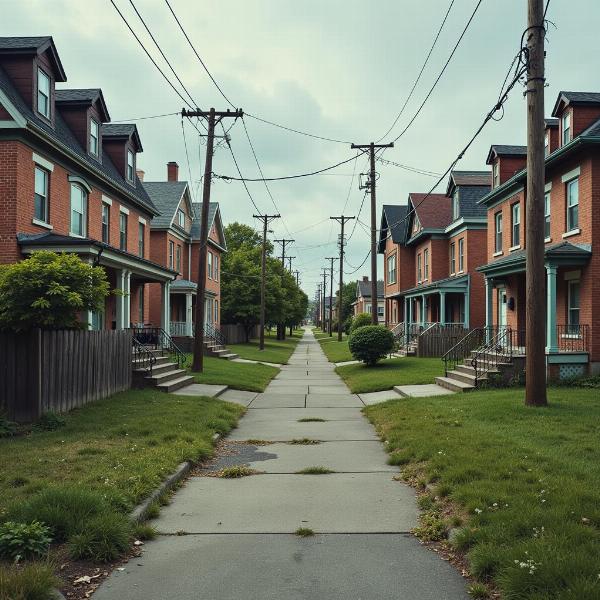Ghettoization, a term increasingly relevant in today’s diverse world, often sparks questions about its meaning, especially within the Indian context. Understanding “ghettoization meaning in Hindi” goes beyond a simple translation; it requires delving into the social, economic, and cultural implications of segregated communities. This article explores the various facets of ghettoization, its historical context, and its impact on individuals and society, particularly within India.
What Does Ghettoization Mean?
Ghettoization refers to the confinement of a particular group of people to a specific area, often due to factors like ethnicity, religion, or socioeconomic status. This segregation can be physical, social, or economic, leading to disparities in opportunities and resources. The term originates from the historical segregation of Jewish communities in Venice, Italy, but its implications resonate globally, including in India. While the Hindi translation might vary (बस्तीकरण, अलगाव, or ghetto itself being used), the core concept remains the same: the creation of isolated communities often facing discrimination and limited access to essential services.
 Visual representation of ghettoization
Visual representation of ghettoization
Ghettoization in the Indian Context
India, with its rich diversity, also grapples with the challenges of ghettoization. Though not always as overt as in some Western societies, segregation manifests in various forms. Caste-based discrimination, religious segregation, and the concentration of migrant workers in specific urban pockets are examples of ghettoization in India. These segregated communities often face limited access to education, healthcare, and employment opportunities, perpetuating a cycle of poverty and marginalization.
The Impact of Ghettoization
The consequences of ghettoization are far-reaching and impact various aspects of life within these communities. Limited access to quality education hampers social mobility, while inadequate healthcare contributes to health disparities. Economic opportunities are often restricted, leading to unemployment and poverty. Furthermore, ghettoization can foster social tensions and create breeding grounds for prejudice and discrimination.
Addressing Ghettoization: A Path Towards Inclusion
Combating ghettoization requires a multifaceted approach. Promoting inclusive policies that ensure equal access to education, healthcare, and employment opportunities is crucial. Investing in infrastructure development and community upliftment programs within marginalized areas can help bridge the gap in living standards. Furthermore, fostering inter-community dialogue and promoting social harmony are essential for breaking down barriers and fostering a sense of belonging.
Ghettoization and Urban Planning
Urban planning plays a critical role in either exacerbating or mitigating ghettoization. Thoughtful urban design that promotes mixed-income housing and ensures access to essential services for all can help prevent the formation of segregated communities. Creating public spaces that encourage interaction between different groups can foster social cohesion and break down barriers.
Conclusion
Understanding “ghettoization meaning in Hindi” is crucial for addressing the challenges of segregation in India. Recognizing the various forms it takes and its impact on individuals and communities is the first step towards creating a more inclusive and equitable society. By promoting inclusive policies, investing in community development, and fostering inter-community dialogue, we can work towards dismantling the walls of segregation and building a society where everyone has the opportunity to thrive.
FAQ
-
What is the closest Hindi translation for ghettoization? While a direct equivalent is debated, terms like बस्तीकरण (bastikaran – forming settlements) and अलगाव (alagao – separation) are often used. The word “ghetto” itself is also commonly used.
-
How does ghettoization impact education? Ghettoized communities often have limited access to quality schools and resources, impacting educational attainment and future opportunities.
-
What role does urban planning play in ghettoization? Urban planning can either exacerbate or mitigate ghettoization depending on how it addresses issues of mixed-income housing and access to essential services.
-
How can we address ghettoization in India? Through inclusive policies, community development, and fostering inter-community dialogue.
-
What are the long-term consequences of ghettoization? Perpetuation of poverty, increased social tensions, and limited opportunities for marginalized groups.
Ghettoization and its impact on social mobility
Dr. Anjali Sharma, a renowned sociologist, emphasizes the detrimental impact of ghettoization on social mobility: “Segregated communities often face systematic disadvantages that hinder their progress, creating a cycle of poverty and limited opportunities.” Mr. Rohan Verma, an urban planner, adds: “Inclusive urban planning plays a vital role in breaking this cycle by ensuring equal access to resources and opportunities for all communities.” Ms. Priya Patel, a community activist, highlights the importance of grassroots initiatives: “Empowering marginalized communities through education and skill development is crucial for fostering social mobility and creating a more equitable society.”
Meaning-Hindi.in is your trusted partner for professional translation services, specializing in various domains, including business, legal, technical, website localization, and academic translations. Our expertise extends to both Hindi and English, ensuring accurate and culturally sensitive translations. Whether you need document translation, website localization, or specialized translation services, we cater to your diverse needs. Contact us today at [email protected] or +91 11-4502-7584 to discuss your translation requirements. Meaning-Hindi.in is committed to delivering high-quality, accurate, and timely translation solutions to bridge language barriers and facilitate effective communication.